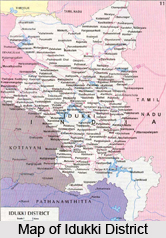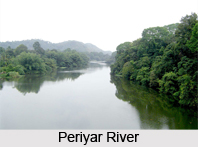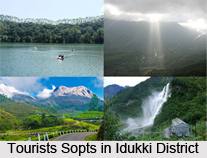 Idukki is one of the fourteen districts of Kerala. The name, "Idukki" is supposed to be derived from the Malayalam word `Idukku` which means a narrow ravine. Its main magnetism lies in its Mountains, Valleys, dams, wildlife sanctuaries, Hill Stations and beautiful lakes. The population of this district mainly consists of tribal people. Munnar hill station is one of the best-attracted places in Idukki. The district headquarter of Idduku is Kuyilamala. The district is often considered as a `Paradise` with its entire natural grandeur.
Idukki is one of the fourteen districts of Kerala. The name, "Idukki" is supposed to be derived from the Malayalam word `Idukku` which means a narrow ravine. Its main magnetism lies in its Mountains, Valleys, dams, wildlife sanctuaries, Hill Stations and beautiful lakes. The population of this district mainly consists of tribal people. Munnar hill station is one of the best-attracted places in Idukki. The district headquarter of Idduku is Kuyilamala. The district is often considered as a `Paradise` with its entire natural grandeur.
History of Idukki District
Idukki district was formed as per Government notification on 24th January 1972. The district consists of Devikulam, Udumbanchola and Peermedu taluks of the former Kottayam district and Thodupuzha taluk excluding two villages Manjallore and Kalloorkadu of the former Ernakulam district. At the time of formation the district headquarters started functioning at Kottayam. It was later shifted to Painavu in Thodupuzha taluk in June 1976, where it is proposed to build a new planned forest township.
Geography of Idukki District
The district is located in the middle part of Kerala. The four borders of the District can be described, as on the East there is Madurai District of Tamil Nadu while on the West it is covered by Ernakulam and Kottayam Districts of Kerala. In the South it is the Pathanamthitta District, while on the North it is bound by Trichur and Coimbatore District of Kerala and Tamil Nadu States respectively.
It lies between 9 degree 15` and 10 degree 21` of north latitude and 76 degree 37` and 77 degree 25` of east longitudes.
Idukki covering 13 percent of the state usually ranks first among the other districts in the state in respect of area. It has an area of 5,087 square kilometer, which extends by 115 kilometers from south to north and 67kilometers from east to west. Rugged mountains and forests cover about 97 percent of the total area.
The notable mountain ranges of the region are Anamala, Eravimala, Tathumala, Chenthavara, Kumarickal, Karimkulam, Devimala, Perumal, Ghudoor, Kabhula, Devicolam, Anchanad, Sabarimala and Karimala. The Periyar River, Thodupuzhayar and Thalayar are the significant rivers of the Idukki district.
As far as the climate of the region is concerned one experiences a sudden variation as one move from the west to the east. The western part of the district experiences a moderate climate and the temperature ranges between 21degree C and 27 degree C, while the eastern parts located in the highland have a comparatively cold climate with temperature varying between minus 1degree C to 15 degree C in November-January and 5 degree C to 15 degree C during March-April.
 The district receives a lot of rainfall from both the south-west and the north-east monsoon winds and it ranges varies from 250 to 425 cms. The forest and wildlife of Idukki district is in true sense very captivating and its immensity can be seen in the range of flora fauna and the variety of birds. Wild life of Idukki District includes Idukki wildlife sanctuary, Chinnar wildlife sanctuary and Perriyar wild life sanctuary.
The district receives a lot of rainfall from both the south-west and the north-east monsoon winds and it ranges varies from 250 to 425 cms. The forest and wildlife of Idukki district is in true sense very captivating and its immensity can be seen in the range of flora fauna and the variety of birds. Wild life of Idukki District includes Idukki wildlife sanctuary, Chinnar wildlife sanctuary and Perriyar wild life sanctuary.
Demography of Idukki District
According to 2001 Census, out of the total population of 11, 29,221 numbers, 5,66,682 numbers are male while 5,62,539 numbers are female and the total density is 259 Sq. Km. The growth rate of the districts is 6.96 and total child population is 1,34,177 in numbers. In the Idukki district the number of Scheduled castes is 1, 59,362 while scheduled tribe are 50,973 in number. The total literacy rate is 88.69 percent, which is given as 8, 82,458. All these data were collected in 2001 census.
Idukki is the second largest place in Kerala where the most number of scheduled tribes exist. There are 245 tribal settlements in the District of which 74 are in Thodupuzha; 11 in Peermedu; 126 in Devikulam and 34 in Udumbanchola Taluks. Almost all the scheduled tribes live in the extreme remote hilly banks and in the deep interiors of thickly growing forests of the district. According to the latest Census the number of tribal families inhabiting in the district is around 11516.
Education of Idukki District
For the Administrative convenience and for improving the efficiency of school administration the Revenue District is divided into 2 Educational districts and further into 7 Educational Sub-district. In this Idukki district 64 Schools are having higher secondary courses. Out of which 23 are Govt. schools, 32 are Govt. aided schools and 9 are unaided schools. Some engineering colleges as well as some arts and science colleges are also present here.
Economy of Idukki District
Agriculture is the main occupation of the people in Idukki District. Dairy is the main supplementary source of income of the farmers in the district. The agro-climatic conditions is suitable for the cultivation of plantation crops and these includes tea, coffee, rubber, coconut, cardamom, pepper, etc. Animal husbandry or farming activities are the major subsidiary occupations of the farming community. Other than this, Nagarjuna Herbal Factory, Crumb rubber factory and Tata Tea, RBD, AV Thomas & Co are the major Industries in Idukki district.
Tourism of Idukki District
Idukki District is well known as popular place of tourist destination. The district is famous for its natural beauty as well as it is known for its wide variety of flora and fauna.
 The region always attracts tourist because of its vast range of places that includes wildlife sanctuaries, Hill stations, Dams, Space plantation tours, Mountain treks, elephant rides, etc. Some of the well known tourist destinations of the district are Munnar, Pothamadu, Devikulum, Pallivasal, Attukal, Nyayamakad, Chithirapuram, Lock Heart Gap, Rajamala, Echo point, Eravikulum National Park, Power House waterfalls, Kundala, Anayirankal, Marayoor, Cheeyappara and Chinnar Wild Life Sanctuary etc. Some of the places around the district which attract large number of tourists are Nadukani, Thumpachi Calveri Samuchayam, Kulamavu, Painavu, Cheruthoni, Kalliyanathandu etc.
The region always attracts tourist because of its vast range of places that includes wildlife sanctuaries, Hill stations, Dams, Space plantation tours, Mountain treks, elephant rides, etc. Some of the well known tourist destinations of the district are Munnar, Pothamadu, Devikulum, Pallivasal, Attukal, Nyayamakad, Chithirapuram, Lock Heart Gap, Rajamala, Echo point, Eravikulum National Park, Power House waterfalls, Kundala, Anayirankal, Marayoor, Cheeyappara and Chinnar Wild Life Sanctuary etc. Some of the places around the district which attract large number of tourists are Nadukani, Thumpachi Calveri Samuchayam, Kulamavu, Painavu, Cheruthoni, Kalliyanathandu etc.
Hence it can be concluded saying that the district of Idukki in the state of Kerala is a heaven for the tourists as it has been abundantly blessed with the bounty of nature.






